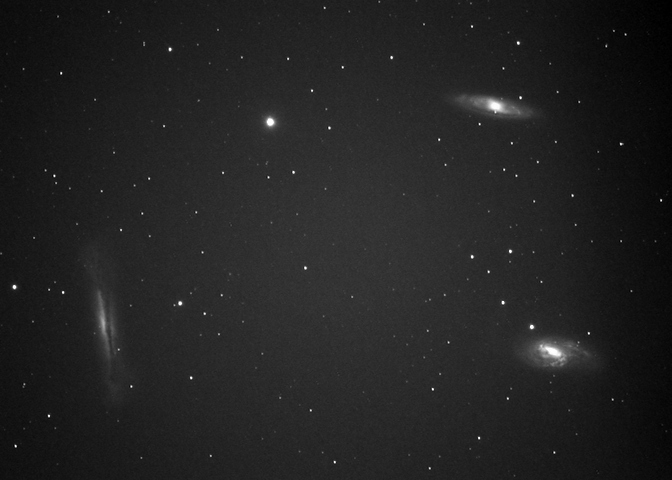
Comet PanSTARRS, Leo Triplet Galaxies,
& Dwarf Planet Makemake
Posted: 15 March 2013
During the day on Thursday, 14 March 2013, I mounted my recently purchased Antares 7x50 illuminated crosshairs finderscope on the Meade 8" LX200-ACF:

The observatory was then opened at 1806 MST, 90°F. Using the crescent moon, I did some initial tests of the finderscope. My review will be posted soon.
Using SkySafari Pro on the iPhone to control the 8" LX200-ACF, I did a GOTO Comet C/2011 L4 (PanSTARRS). It was viewed through the telescope using 77X at 1844 MST. Only the comet's head was visible against the bright sky 13 minutes after sunset. I attached a focal reducer and continued to observe the comet. Initially, only the bright nucleus was visible. At 1854 MST, coma around the head became visible. At 1855 MST, the comet became visible in the Antares 7x50 finderscope. At 1903 MST, a short tail became visible with the 8" telescope. At 1905 MST, I mounted the iPhone 4 on the telescope using the MX-1 afocal adapter and began taking photographs of the comet at 77X using the Camera app. This cropped image taken at 1911 MST shows the comet and some of the tail:

The comet was bright enough that even a smartphone camera could capture it.
This handheld D7000 DSLR photograph, 1925 MST, f/4.2, 1/2sec, ISO 2000, 34mm (slightly cropped), shows the crescent moon and some Earthshine at top with Comet PanSTARRS just above the trees at the lower right:

I removed the focal reducer from the telescope at 1934 MST and took a last look at the comet, 77X, now low in the sky and into tree limbs.
I then did some lunar observing, 206X. There were some nice views. Especially nice was the view of Mare Humboldtianum on the lunar limb. I then viewed Jupiter and its four Galilean Moons.
At 1952 MST, I slewed to M105 and began preparing to image the M105, NGC3384, and NGC3389 galaxy triplet in the constellation of Leo. I did a focus test on Regulus using the Bahtinov Mask and then I did a framing test exposure of the galaxies, having found a good guide star. At 2034 MST, I captured this 5 minute, ISO 6400, prime focus, guided image of M105 (top), NGC3384 (left), and NGC3389 (right) galaxies:

A satellite crossed the field-of-view during the exposure, but I decided to keep the image.
For imaging the M65, M66, and NGC3628 triplet of Leo galaxies, I added the focal reducer. Did another focus test on Regulus with the Mask. I did several framing test images as I searched for a guide star in the illuminated reticle eyepiece on the off-axis guider. Unfortunately, no guide star was found. I decided to take some unguided short exposures that I could stack. This is a stack of three exposures of 60 seconds, 180 seconds, and 150 seconds, ISO 6400, using Lynkeos, for an effective exposure of 6.5 minutes, showing M65 (top right), M66 (bottom right), and NGC3628 (left):

My last imaging target for the night was the dwarf planet Makemake, Magnitude +16.9. I removed the focal reducer and connected the iPhone to the telescope. Using SkySafari Pro, the telescope was slewed to Makemake. I found a guide star and did a 10 minute, ISO 6400, guided exposure. I wanted to confirm that the image I had taken on the previous night captured Makemake:

This animation from both nights shows the motion of the dwarf planet in about 24 hours:

Ignoring the digital noise "movement", it is obvious from the motion visible in the lower right quandrant, that I did indeed capture the dwarf planet Makemake on both nights.
Closed the observatory at 2203 MST, 64°F.
Comments are welcome; use the Comments section below, or you can Email Me. Thanks.
Go to the previous report.
Return to the Cassiopeia Observatory Home Page.